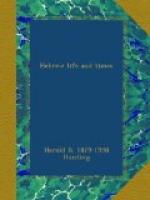According to all the Hebrew records, the covenant at Sinai was embodied in a divinely given Decalogue, or a set of ten short commands, which could be counted off on the ten fingers. Two Decalogues are given in Exodus, as coming from Moses at Sinai. One is in Exodus 34. 17-28. The other is the well-known Decalogue in Exodus 20. The former has to do largely with sacrifices and ritual observances. The latter, with its stern demands for right conduct toward one’s fellow men, and for the worship of Jehovah rather than idols, expresses well the new moral and religious impulses which came to the Hebrews under the leadership of their first great deliverer.
In its original form the Decalogue probably read something as follows:
=Thou shalt have no other gods before me.= =Thou shalt not make unto thee any graven (or molten) image.= =Thou shalt not take the name of Jehovah thy God in vain.= =Remember the Sabbath day to keep it holy.= =Honor thy father and thy mother.= =Thou shalt not kill.= =Thou shalt not commit adultery.= =Thou shalt not steal.= =Thou shalt not bear false witness against thy neighbor.= =Thou shalt not covet.=
STUDY TOPICS
1. Read in Hastings or any other modern Bible dictionary, the article on “Exodus.” Note the testimony of modern travelers on the effect of high winds on the upper part of the Red Sea.
2. Where was Mount Sinai? Look up in Bible dictionary.
3. Draw a map, showing the probable route of the Hebrews after leaving Egypt.
4. What part of the Ten Commandments seems most to reflect the influence of the great deliverance from Egypt? Read Deuteronomy 5. 12-15.
5. Test your memory for the Ten Commandments in their brief form as given in this chapter.
6. The records of the events of this chapter are found in Exodus, chapters 6-12, 14, and 15. Read as much of this as your time will permit.
CHAPTER VI
FROM THE DESERT INTO CANAAN
Once safely out of Egypt, the next problem for Moses and his people was to find a way into Canaan. Through all the centuries the wandering shepherds on the edge of the desert have looked with longing eyes on the fertile valleys and plains of Palestine. To have a settled, comfortable home, with cisterns of water as well as springs and wells; to have fields of wheat, vineyards of grapes, and gardens of melons and all luscious fruits—this is the picture that haunts the wandering Arab, amid the hardships and monotony of his desert life.




